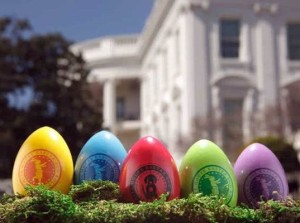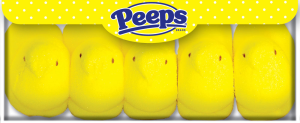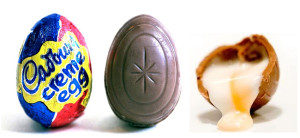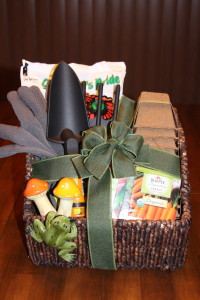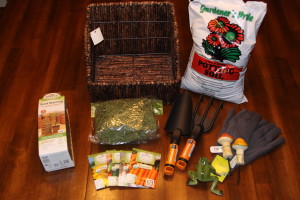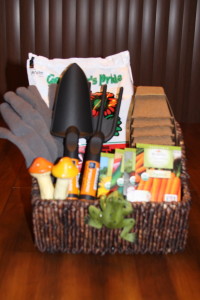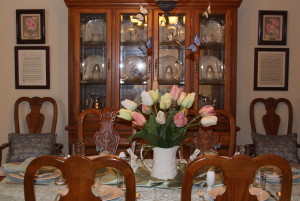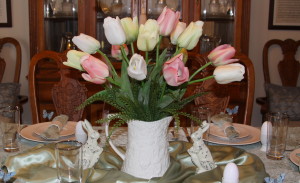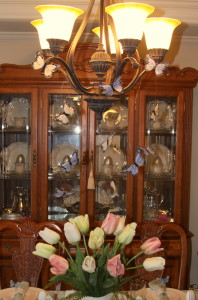April Fool’s Day is a day of pranks and practical jokes… but how did it all get started.
Centuries ago, the Romans held an eight day festival at the time of the vernal equinox and was an ancient religious celebration honoring Cybele, the mother of the gods. The Romans celebrate that winter was over and the days were again longer than the nights. On the final day of the celebration, known as the Hilaria, there was solemn procession of a statue of Cybele carried throughout the streets preceded by a show of wealth in the form of gold and works of art belonging to the emperors or other wealthy Romans. This was usually followed by an elaborate masquerade in which the people would disguise themselves as people of power and prestige.
In Medieval times there was the Feast of Fools, starting in the fifth century and ending in the sixteenth centuries, it was celebrated in several countries in Europe mainly in France but also in Spain. At these celebrations the participants would often mock the power and dignity of the church’s highest clergy. They would congregate around a church, dress themselves in different masks and disguises, engage in all types of song and dance, and perform a ridiculous parody directed toward the offensive person naming them the “Lord of Misrule”. These types of celebration always occurred during periods of social and religious revolution.
Famous April Fool’s Day Pranks
- On April1, 1860, people throughout London received the following invitation to come to the Tower of London to view the annual ceremony of the “Washing the White Lions”. Admittance was only at the White Gate entrance and it was requested that no gratuities be given to wardens or attendants. By noon a large crowd had reportedly gathered outside the Tower of London and when they realized nothing was going to happened they left very disappointed. In Fact, lions hadn’t been kept at the Tower for centuries and in particular never white lions. This prank in still often used today on unsuspecting visitors to London.
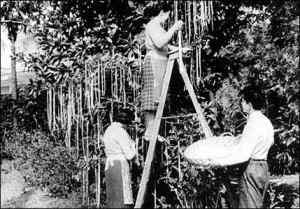 On April 1, 1957 the British news show Panorama broadcast a three-minute segment about a bumper spaghetti harvest in southern Switzerland and showed a film of workers harvesting the crop from the “spaghetti trees”. The success of the crop was attributed both to an unusually mild winter and disappearance of the “spaghetti weevil.” The Swiss Spaghetti Harvest hoax generated an enormous response and hundreds of people phoned the BBC wanting to know how they could grow their own spaghetti tree. In response the BBC diplomatically replied, “Place some spaghetti in a tin of tomato sauce and hope for the best.
On April 1, 1957 the British news show Panorama broadcast a three-minute segment about a bumper spaghetti harvest in southern Switzerland and showed a film of workers harvesting the crop from the “spaghetti trees”. The success of the crop was attributed both to an unusually mild winter and disappearance of the “spaghetti weevil.” The Swiss Spaghetti Harvest hoax generated an enormous response and hundreds of people phoned the BBC wanting to know how they could grow their own spaghetti tree. In response the BBC diplomatically replied, “Place some spaghetti in a tin of tomato sauce and hope for the best.- In 1965 BBC TV featured an interview with a professor who had just invented a device called “Smellovision.” This miraculous technology allowed viewers to experience in their own home aromas produced in the television studio. The professor demonstrated this new device by cutting some onions and brewing coffee. Surprisingly a number of viewers called in to confirm that it was working and they smelled these scents through their television sets. Since no aromas were being transmitted, whatever these viewers thought they smelled was due to the power of suggestion.
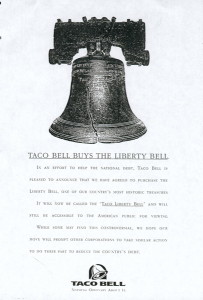 On April 1, 1996 a full page ad from the fast food chain Taco Bell appeared in six major American newspapers announcing that in an effort to help the national debt, they had agreed to purchase the Liberty Bell, were renaming it the “Taco Liberty Bell”. The ad generated an enormous response and thousands of concerned citizens called the Taco Bell’s headquarters in Irvine and the National Park Service in Philadelphia to find out if the Bell had really been sold. Later that same day, Taco Bell issued a press release in which they confessed to the hoax and also announced that it would donate $50,000 for the upkeep of the Liberty Bell.
On April 1, 1996 a full page ad from the fast food chain Taco Bell appeared in six major American newspapers announcing that in an effort to help the national debt, they had agreed to purchase the Liberty Bell, were renaming it the “Taco Liberty Bell”. The ad generated an enormous response and thousands of concerned citizens called the Taco Bell’s headquarters in Irvine and the National Park Service in Philadelphia to find out if the Bell had really been sold. Later that same day, Taco Bell issued a press release in which they confessed to the hoax and also announced that it would donate $50,000 for the upkeep of the Liberty Bell.- Burger King published a full page advertisement in the April 1, 1998 edition of USA Today announcing the introduction of a new item to their menu: a “Left-Handed Whopper” specially designed for the 32 million left-handed Americans. According to the advertisement, the new whopper included the same ingredients as the original Whopper (lettuce, tomato, hamburger patty, etc.), but all the condiments were rotated 180 degrees for the benefit of their left-handed customers. The following day Burger King issued a news release revealing that although the Left-Handed Whopper was a hoax, thousands of customers had gone into restaurants to request the new sandwich.
- On April 1, 2008, the BBC announced that camera crews filming near the Antarctic for its natural history series Miracles of Evolution had captured footage of the “flying” Adélie penguins and explained that instead of huddling together to endure the Antarctic cold, these penguins would fly thousands of miles to the rainforests of South America where they would spend the winter in the tropical sun.”

